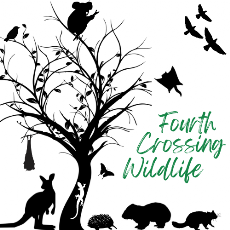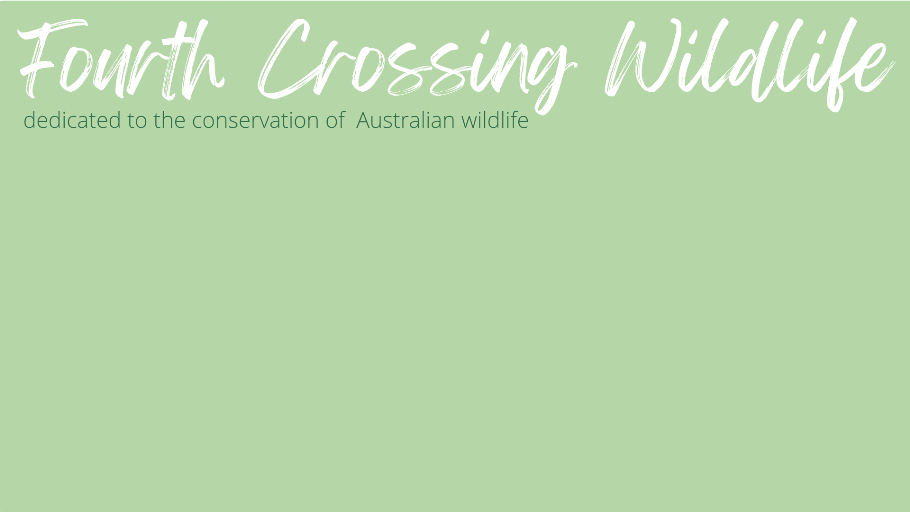Stories
Wombats : The Big Picture
by Linda Dennis
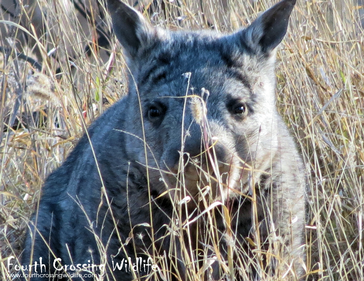 Northern Hairy-nosed Wombat 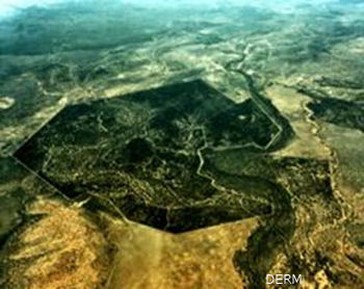 Epping Forest Scientific National Park 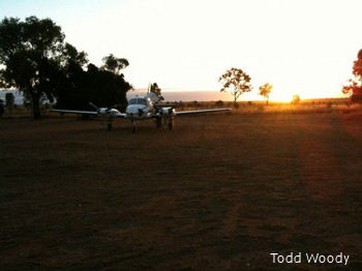 The Wombat Express  Neil, the first Northern Hairy-nosed Wombat to be translocated to RUNR 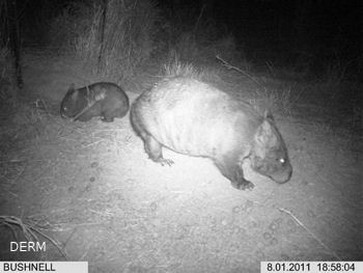 Northern Hairy-nosed Wombat mum and joey at RUNR 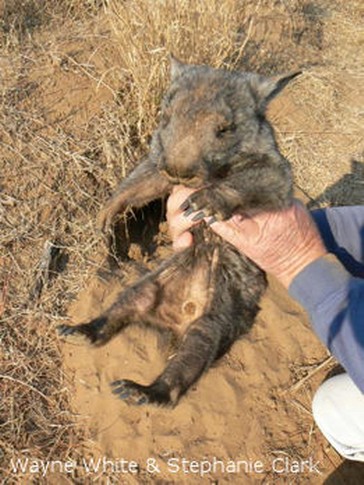 Harriet, the Northern Hairy-nosed Wombat joey rescued at Epping Forest 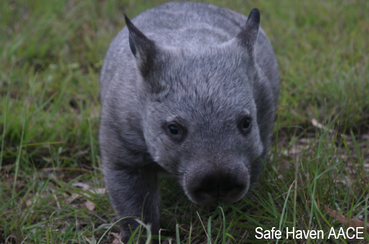 Harriet, while in care at Safe Haven AACE Southern Hairy-nosed Wombat 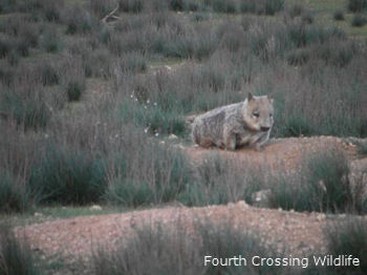 Southern Hairy-nosed Wombat with Sarcoptic Mange (Portee Station, SA) 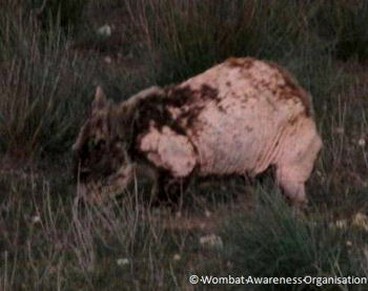 Southern Hairy-nosed Wombat showing symptoms of a toxic liver disease 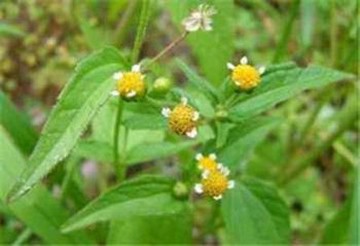 Potato weed 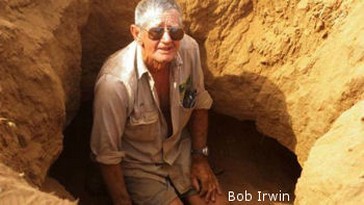 Bob Irwin, opening ploughed over burrows 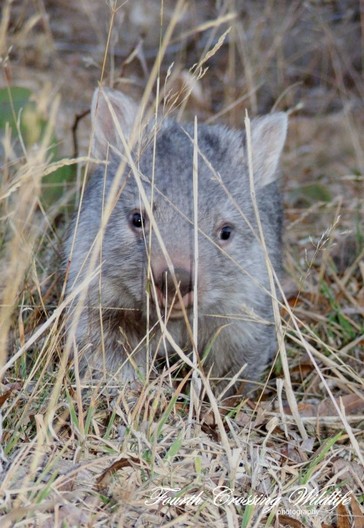 Bare-nosed Wombat 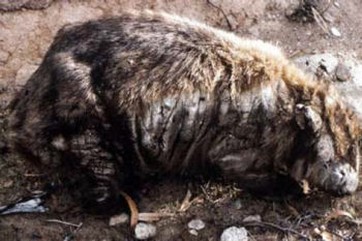 A Bare-nosed Wombat suffering fatal Sarcoptic Mange 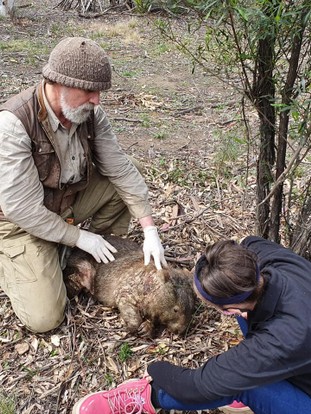 John Creighton from Wombat Care Bundanoon and Beth Nasser from Wombat Stomp Wildlife treat a mange infested Bare-nosed Wombat 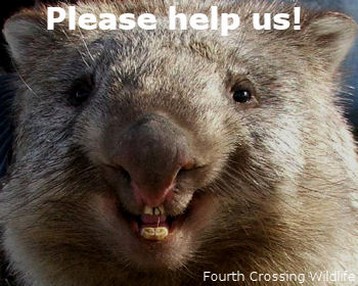 Please help organisations that are fighting to protect wombats | Wombats - they have been described as "The Hobbits of the Australian Bush". They are secretive creatures who spend most of their time asleep underground, venturing out in the cool, dark of night. Because they are rarely seen wombats remain a mystery to most people. There are many Australians who have never even seen a wombat in the wild. The wombat is certainly one of Australia's lesser known marsupials, unlike the koala and kangaroo. Australia has three species of wombat: The Bare-nosed Wombat (also known as the Common Wombat) -Vombatus ursinus, the Southern Hairy-nosed Wombat - Lasiorhinus latrifons, and the Northern Hairy-nosed Wombat - Lasiorhinus krefftii, also known as Yaminon. All three species of wombat are in trouble, facing many and varied threats - some of these threats are more severe than others. The Northern Hairy-nosed Wombat - Australia's second most endangered animal - is at the top of the concern list. Ironically, it is also considered the most secure of the three species as much work has been done - and is being done - to save the species from tipping over the edge of extinction. In the entire world there is only just over 300 Northern Hairy-nosed Wombats left, classifying the species as endangered by the Australian Federal Government and Critically Endangered on the IUCN Red List. There are no Northern Hairy-nosed Wombats in captivity and there are only two wild populations, one is located in central Queensland: Epping Forest National Park (Scientific) near Clermont and The Richard Underwood Nature Refuge near St George is in Southern Queensland. It is thought that the Northern Hairy-nosed Wombat was already a rare species at the time of European settlement, although it could be found in pockets of inland Eastern Australia from Victoria to Queensland. After European settlement however the species declined further due to habitat loss, farming and predation. By mid 1970's it was estimated that there were only 35 individuals left in one single population at Epping Forest. With the implementation of Queenslands Department of Environment and Heritage Protection (EHP) "Northern Hairy-nosed Wombat Recovery Plan" which included projects such as the erection of the wild dog fence and the installation of water and feed troughs through the park the species saw a slow but steady increase. In 2000 the first Northern Hairy-nosed Wombat Hair Census was conducted, where hair samples were collected (using double sided sticky tape traps at burrow entrances) and DNA extracted to determine the number of individuals in the population - 113 at that count. In the same year, a pack of dogs entered the area and at least ten individuals were killed. The 20 kilometre wild dog fence was erected as a result. Ten individuals was a huge loss to an already fragile population. Eager volunteers from around the globe helped to conduct a Hair Census every two to three years from then on. The 2003 census recorded a decline to 90 wombats, as a result of the dingo predation event. The 2007 Hair Census counted 138 individual wombats. The DNA analysis results from the 2010 hair census and with breeding occuring at RUNR there were thought to be around 216 wombats. The last census in 2020 indicates there are 315 individuals. There have been several sightings of wombat joeys at Epping Forest and two births have been recorded at the new colony at the Richard Underwood Nature Refuge (RUNR). This new colony at RUNR began with the first individual being flown from Epping Forest in 2009. Neil was his name - named after Neil Armstrong, the first man on the moon because he was flown down on the 40th anniversary of the moon landings, on July 21 2009. Fourteen more wombats followed over a period of around thirteen months, travelling by plane - dubbed The Wombat Express - and by road. The pitter patter of little feet at RUNR - along with new young viewed at Epping Forest - has heralded a major success for the Northern Hairy-nosed Wombat Recovery Plan. The first RUNR joey ventured out of its burrow in early October 2011 and was captured on video frolicking at the burrow entrance. The second joey appeared only a week later. The news caused quite a commotion and celebration among wombat conservationist throughout Australia and the world. In 2010, two very observant (and oh so lucky) caretakers at Epping Forest - Stephanie Clark and Wayne White - quite literally stumbled on a young Northern Hairy-nosed Wombat in desperate need of help. Harriet, named by Stephanie and Wayne, was found huddled up in a small burrow, far away from any burrow systems. At first they thought it was a Swamp Wallaby, but when they pulled the small animal out they found a Northern Hairy-nosed Wombat joey. She was in a bad way - incredibly dehydrated, distressed, with patches of fur missing and blisters on her feet. Being wildlife carers, Stephanie and Wayne knew what to do and first aid was provided. Once settled, Harriet was sent to Tina Janssen from Safe Haven AACE, who cared for Harriet until release. Harriet was later renamed "Princess Hobo" as she turned out to be true "little miss" as is the wombat way! Harriet, AKA Princess Hobo, was released at RUNR. Sad news is that Harriet has since died. With two separate colonies established the Northern Hairy-nosed Wombat is now protected from disasters such as drought, fire and disease - which was a concern when only the one colony at Epping Forest existed. Organisations such as the The Australian Wildlife Society and The Wombat Foundation are helping to raise awareness of the Northern Hairy-nosed Wombat. The Wombat Foundation has implented the yearly "Hairy-nose Day" on May 11th. On Hairy-nose Day schools are invited to pitch in to help save the endangered species by wearing hairy noses and collecting donations that will directly aid the conservation of the Northern Hairy-nosed Wombat. The Southern Hairy-Nosed Wombat is not as well protected as its northern cousin. Although greater in number there are many threats that face the Southern Hairy-nosed Wombat: land clearing, farming and competition with domestic stock, predation, roadkill and injury, disease and illness, introduction of pest species and - rather disturbingly - human persecution. In South Australia there are several isolated pockets that are home to Southern Hairy-nosed Wombat, namely the Nullarbor Plains and Far West, the Eyre Peninsula, the Gawler Ranges and the Murraylands with smaller colonies dotted around Yorke Peninsula. Southern Hairy-nosed Wombat can also be found in the south-eastern corner of Western Australia which makes up part of the Far West colony. The Murraylands and Far West regions are the main strongholds for the Southern Hairy-nosed Wombat and are considered to be a "continuous population" where as the Yorke Peninsula has thirty four smaller, isolated colonies with an estimated count of about 690-odd individuals, as tallied in studies conducted by Dr Elisa Sparrow and the University of Adelaide from 2006 to 2008. As with the once single colony of Northern Hairy-nosed Wombat (before the RUNR translocation) these smaller isolated pockets of Southern Hairy-Nosed Wombat are under serious threat from fire, drought and disease. In recent history the debilitating and most often fatal disease Sarcoptic Mange entered colonies of Southern Hairy-nosed Wombat. As a relatively new disease Sarcoptic Mange has created havoc in many Southern Hairy-nosed Wombat populations. It is thought that the Bare-nosed Wombat has - over many years - built up some resistance to the disease, however the Southern Hairy-nosed Wombat has been hit hard and local populations have been decimated. Similarly, a new disease discovered by the Wombat Awareness Organisation (WAO) of South Australia in mid 2011 has done great damage to the status of the Southern Hairy-nosed Wombat. WAO estimated that 70% of the Murraylands Southern Hairy-nosed Wombat population has been affected by the dreadful, mysterious disease. Dr Wayne Boardman and Dr Lucy Woolford, vets with Adelaide University, are currently researching the disease. Initially, it was thought it was a fungal infection, however it is now thought to be a toxic liver disease, brought on by the ingestion of a weed known as potato weed. This weed is site specific meaning not all the population are likely to be impacted, but it is only a new disease and much more research needs to be done. Potato weed, which was introduced to southern Australia in the 19th century and has since spread across most of the continent, contains pyrrolizidine alkaloids (PAs), chemicals that protect them from insects but which can be fatal or dangerous to many animals. Once an individual shows signs of the disease, the downward slide is rapid. Onset is fur loss, then malnutrition and finally organ failure. Many wombats have died. Good Southern Hairy-nosed Wombat habitat is now hard to find. Many landowners view the wombat as pests as burrows are often dug within productive farm land and so wombats are eradicated or dispersed into areas of not so favourable land with little food, water or suitable soil for digging burrows. It is heartening to see that not all land owners think this way. Dr Elisa Sparrow conducted a statewide survey in 2011 and 2012, and whilst some landowners saw wombats as a nuisance or pest, more than 80% of landowners believe wombats should be conserved and believe co-existence between landowners and wombats is possible. Wombats SA is one conservation organisation that is purchasing good habitat where the wombats are protected. Portee Station near Blanchetown in the Murraylands district is one such parcel of land. 2020 hectares of Portee Station was purchased by Wombats SA is now protected and wombats have been thriving in the good quality habitat. The reserve was established in 1968 and is called Moorunde, Edward Eyre's name for the area. Eyre was the first European settler who, along with his Aboriginal friend Wylie, crossed South Australia from east to west by foot. 6900 hectares of land surrounding Moorunde have since been purchased by Wombats SA and a fifty kilometre long wildlife corridor now existsin the region. It is thought that there are around 2000 individual Southern Hairy-nosed Wombat living on the extended Moorunde reserve. Sadly, due to dry conditions of late, the habitat and grass cover at Moorunde and Portee Station has deteriorated somewhat. Potato weed and other weed cover, together with over grazing by other species such as kangaroos, has left very little edible grasses for the wombats and they are forced to eat unfamiliar species like the deadly potato weed, which is causing the often fatal toxic liver disease. Wombats SA is now re-seeding native grasses at Moorunde with the help of volunteers. They are also allowing some areas to regenerate by enclosing them. The most disturbing news for the Southern Hairy-nosed Wombat is human persecution. Some landowners view wombats as pests and burrows are considered a huge inconvenience. Burrows are quite simply ploughed over by some landowners - trapping live wombats deep within the warren style burrow systems. These wombats are doomed to die a slow and painful death without air or food. Bob Irwin along with volunteers made news headlines in 2010 when they entered land to re-open ploughed burrows. Wombats were seen and heard by Bob and his team within these burrows - even young joeys were seen! Unfortunately, it would seem that wildlife authorities in the area do little to combat this cruel and inhumane practice of "controlling" wombats and it is still known to happen today. The Conservation Ark and Zoos SA are also working to save the Southern Hairy-nosed Wombat from decline. Wombat Musters, headed by Dr Elisa Sparrow and Dr David Taggart, are regularly conducted with the help of eager volunteers. Wombats are captured, tagged, weighed, and data such as sperm is collected before the animals are returned back to the wild. Data collected from the musters help manage populations as well has monitor the impacts of climate change on the species. Data is also used to help conservation efforts for the Northern Hairy-nosed Wombat. Safe Haven AACE is another organisation working hard to protect Southern Hairy-nosed Wombats. A captive breeding program was established in 2009 with the help of the University of Queensland. Research to be carried out by Safe Haven: • Reproduction and genetics of the Southern Hairy-nosed Wombat • Breeding the Southern Hairy-nosed Wombat as a model for the Northern cousin • Heat stress physiology of free-range and captive wombats • Behavioral ecology of wild wombats • Vocal and auditory communication • Fundamental anatomy and physiology of wombats • Artifcial insemination of the Southern Hairy-nosed wombat Work carried out by Safe Haven AACE has been greatly beneficial in understanding the Northern Hairy-nosed Wombat. The centre provides healthy animals for captive management and breeding to contribute to the recovery of the critically endangered Northern Hairy-nosed Wombat. To conserve the Southern Hairy-Nosed Wombat long term everyone needs to work together and communicate openly - researchers, conservation groups, landholders, government - for it to be most effective. Lastly, and by no means the least, the best looking of the three species - the Bare-nosed Wombat. The Bare-nosed Wombat is classified as common and at no risk. But, if you ask any wombat conservationist what they think and chances are they'd say it was the wombat species most in trouble. Its old name "common wombat" gave the impression that it is a common animal and numbers are in abundance, which may have been the case several years ago, but not today. At a Fauna First Aid wombat care course in southern NSW - which had several members of the Wombat Protection Society of Australia present - participants unanimously voted in the new name of Bare-nosed Wombat and we urge everybody to use this name and turn away from the inappropriate "common" name and the connotations is presents. The Bare-nosed Wombat is facing threats at every level. It's the Southern Hairy-nosed Wombat story repeated but tenfold - land clearing, farming and competition with domestic stock, predation, roadkill and injury, disease and illness, introduction of pest species and again - human persecution. Although protected in NSW, culling permits are easily obtainable - ironically, it's easier to get a wombat culling permit than a carers permit. In Victoria, the Bare-nosed Wombat is now a protected species throughout its range. Roadkill and injury is another big threat. The wombat's greatest sense is smell and danger is often perceived by smelling predators, etc. A vehicle has no smell, at least not until it is quite close, and by that time it's too late, the wombat doesn't react in time and is hit. The biggest threat in most areas where the Bare-nosed Wombat can be found is Sarcoptic Mange. It is thought that the mite that affects wombats - often fatally - is called Sarcoptes scabiei var wombati; however there have been no DNA tests to prove this - it may well be the canine variety of Sarcoptes scabiei that also infests wombats. The irritation caused by the mite burrowing under the skin causes the wombat to scratch incessantly which in itself causes often irreparable damage to the skin including mutilation and hair loss. From the constant scratching, skin layers are taken off and raw flesh is exposed. The blood serum seeps through the mites' tunnels to the exposed flesh creating wounds and scabs. Ulcers and deep lesions develop which then cause secondary infection and blow fly strike. Other visible symptoms of this disease are skin thickening and crusting over the body, including the eye and ear areas causing blindness and deafness. The animal becomes too weak to search for food and malnutrition and dehydration occur. The immune system becomes depleted and the wombat looks emaciated. Advanced stages Sarcoptic Mange also has a devastating effect on internal organs, including the heart, liver, kidneys, lungs and reproductive organs. Respiratory infections and pneumonia can deplete the wombat further. Left without treatment, a wombat with Sarcoptic Mange will die - death is slow and painful. Roz and Kev Holme of Cedar Creek Wombat Rescue (CCWR) at Central Mangrove (NSW) have been caring for wombats for many years and have a continual stream of mange affected wombats passing through their doors. CCWR also carry out treatment regimes on wildlife living wombats. It seems that mainly females without joeys are received into care more regularly, as wombats in this condition don't breed. Sadly, if mange is contracted by a female with a joey she will often reject it as she can't cope with the extra burden, so CCWR tend to keep an eye out for abandoned wombat joeys in the area. Entire colonies of the Bare-nosed wombat are being lost to this horrible disease; however an affected wombat can completely recover if it is treated early. You can help save these animals by reporting cases to your local wildlife organisation or to your local National Parks and Wildlife Service office. Record the time and exact location of the wombat so that it can be found easily by a ranger or wildlife carer. The Wombat Protection Society of Australia, with the help of its members, is currently researching Sarcoptic Mange and they believe this disease can be reversed in many areas of Australia and that many wombats can be saved. The Wombat Protection Society of Australia has designed a "self applicating" pesticide device that can be installed above a burrow eliminating the need of handling wild wombats which can be distressing to the wombat. Wombat Protection will also send out treatment kits to landowners, along with tips on how to treat wombats in the wild. Remember - the quicker you act the more chance a wombat has of survival. Please help to save all our wombats! Below are contact details of those who are working to protect and save wombats. The Australian Wildlife Society PO Box 42 Brighton Le Sands NSW 2216 Tel: (02) 9556 1537 Fax: (02) 9599 0000 Email: info@aws.org.au Web: www.aws.org.au The Wombat Foundation GPO Box 2188 Sydney NSW 2001 Email: enquiries@wombatfoundation.com.au Web: www.wombatfoundation.com.au Department of Environment and Heritage Protection Wombat Survival Fund PO Box 3130 Red Hill QLD 4701 Wombat Protection Society of Australia PO Box 6045 Quaama NSW 2550 Tel: (02) 6493 8245 Web: www.wombatprotection.org.au Zoos South Australia Conservation Ark Dr Elisa Sparrow Tel: 08 8230 1321 Fax: 08 8267 4289 Email: esparrow@zoossa.com.au Web: www.conservationark.org.au Wombats SA PO Box 410 Blackwood SA 5051 Email: info@wombatssa.org.au Web: wombatssa.org.au Facebook: www.facebook.com/NHSSA/ Instagram: wombats_sa Safe Haven AACE PO Box 138 Mount Larcom 4695 Queensland, Australia Web: www.aace.org.au Wombat Care Bundanoon Phone: 0490 659 245 Email: wombatcarebundanoon@gmail.com Web: wombatcarebundanoon.com.au |
